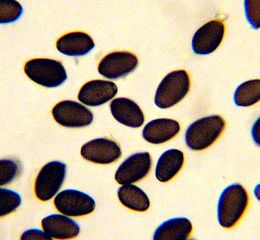Coprinus comatus
| Coprinus comatus | |
|---|---|

| |
| Scientific classification | |
| Domain: | Eukaryota |
| Kingdom: | Fungi |
| Division: | Basidiomycota |
| Class: | Agaricomycetes |
| Order: | Agaricales |
| Family: | Agaricaceae |
| Genus: | Coprinus |
| Species: | C. comatus
|
| Binomial name | |
| Coprinus comatus | |
| Synonyms[2] | |
| |
| Coprinus comatus saprotrophic | |
|---|---|
| Edibility is choice | |
Coprinus comatus, commonly known as the shaggy ink cap, lawyer's wig, or shaggy mane, is a common fungus often seen growing on lawns, along gravel roads and waste areas. The young fruit bodies first appear as white cylinders emerging from the ground, then the bell-shaped caps open out. The caps are white, and covered with scales—this is the origin of the common names of the fungus. The gills beneath the cap are white, then pink, then turn black and deliquesce ('melt') into a black liquid filled with spores (hence the "ink cap" name).[3] This mushroom is unusual because it will turn black and dissolve itself in a matter of hours after being picked or depositing spores.
When young it is an excellent edible mushroom provided that it is eaten soon after being collected (it keeps very badly because of the autodigestion of its gills and cap). If long-term storage is desired, microwaving, sauteing or simmering until limp will allow the mushrooms to be stored in a refrigerator for several days or frozen. Also, placing the mushrooms in a glass of ice water will delay the decomposition for a day or two so that one has time to incorporate them into a meal. Processing or icing must be done whether for eating or storage within four to six hours of harvest to prevent undesirable changes to the mushroom. The species is cultivated in China as food.
Taxonomy
The shaggy ink cap was first described by Danish naturalist
Coprinus comatus is the type species for the genus Coprinus. This genus was formerly considered to be a large one with well over 100 species. However, molecular analysis of DNA sequences showed that the former species belonged in two families, the Agaricaceae and the Psathyrellaceae.[5] Coprinus comatus is the best known of the true Coprinus.
Description
The shaggy ink cap is easily recognizable from its almost cylindrical cap which initially covers most of its stem. The cap ranges from 4–8 cm (1+5⁄8–3+1⁄8 in) in width and 6–20 cm (2+3⁄8–7+7⁄8 in) in height.
Similar species
The mushroom can sometimes be confused with the magpie fungus which is poisonous. In America, the 'vomiter' mushroom Chlorophyllum molybdites is responsible for most cases of mushroom poisoning due to its similarity with shaggy mane and other edible mushrooms.[9] Coprinopsis atramentaria (the common Ink Cap) is similar, and contains coprine and can induce coprine poisoning, particularly when consumed with alcohol.[6] Podaxis pistillaris is also similar.[6]
Distribution, habitat and ecology
It grows in groups in places which are often unexpected, such as green areas in towns. It occurs widely in grasslands and meadows in Europe and North America, from June through to November in the UK. It appears to have been introduced to Australia, New Zealand and Iceland. In Australia the species is sufficiently common to have been featured on a postage stamp issued by Australia Post in 1981.[10]
Coprinus comatus is a nematophagous fungus capable of killing and digesting the nematode species Panagrellus redivivus and Meloidogyne arenaria.[11][12]
Edibility
The young mushrooms, before the gills start to turn black, are a choice
Coprinus comatus is not to be confused with Coprinopsis atramentaria, which can induce coprine poisoning, particularly when consumed with alcohol.[6] Symptoms of coprine poisoning include vomiting, diarrhoea, palpitations and a metallic taste in the mouth.[15]
Gallery
-
Young Coprinus comatus
-
Cross section of young mushroom
-
Old and young individuals
-
Late stage deliquescence of Coprinus comatus mushrooms
-
Coprinus comatus spores
References
Much of the above article was translated from the French page and Dutch pages.
- . Retrieved 22 January 2024.
- ^ "Coprinus comatus (O.F. Müll.) Pers. 1797". MycoBank. International Mycological Association. Retrieved 2012-03-03.
- OCLC 1127137515.)
{{cite book}}: CS1 maint: location missing publisher (link - ^ ISBN 0-14-063005-8.
- JSTOR 1224525.
- ^ OCLC 797915861.
- ^ ISBN 978-0-88192-935-5.
- ISBN 0-330-44237-6.
- ^ Beug, Michael W. An Overview of Mushroom Poisonings in North America. Archived 2010-05-20 at the Wayback Machine The Mycophile, vol. 45(2):4-5, March/April 2004
- ^ AustralianStamp.com Coprinus comatus image
- PMID 21148944.

- PMID 17449690.

- ISBN 978-1-4930-2669-2.
- ISBN 978-0-7627-3109-1.
- ^ Collins, How to Identify Edible Mushrooms by Harding, Lyon & Tomblin
Further reading
- Pierre Montarnal: Le petit guide: Champignons (Genève, 1964; Paris-Hachette, 1969; in French).
- Régis Courtecuisse, Bernard Duhem: Guide des champignons de France et d'Europe (Delachaux & Niestlé, 1994–2000). ISBN 978-2-603-00953-6
- Roger Phillips: Mushrooms and other fungi of Great Britain and Europe (Pan Books Ltd. 1981 / Book Club Associates 1981) - for the English names.






